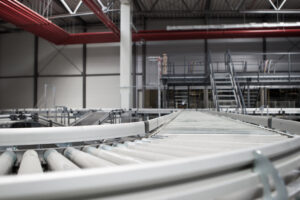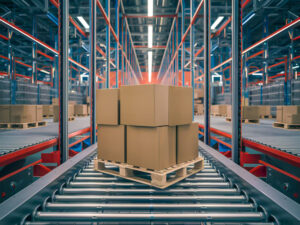The warehouse industry is experiencing a crisis that’s costing businesses millions of dollars annually. With labor costs rising 15% year-over-year and consumer expectations for same-day delivery reaching an all-time high, distribution centers are scrambling to find warehouse efficiency solutions that can keep pace with demand without breaking the bank.
At Lafayette Engineering, we’ve witnessed firsthand how the right warehouse efficiency solutions can transform struggling operations into profit-generating powerhouses. Over our 35+ years in the industry, we’ve helped companies reduce operational costs by up to 40% while simultaneously increasing throughput by 200%.
The Hidden Costs of Warehouse Inefficiency
Most warehouse managers focus on obvious metrics like labor costs and shipping delays, but the real financial drain comes from hidden inefficiencies that compound over time. A recent study by the Material Handling Industry of America revealed that the average warehouse loses $1.2 million annually due to preventable inefficiencies.
These hidden costs include:
Inventory Misplacement: Workers spend an average of 21 minutes per shift searching for misplaced items, translating to 87 hours of lost productivity per employee annually.
Equipment Downtime: Unplanned conveyor system failures cost warehouses an average of $50,000 per incident in lost productivity and emergency repairs.
Order Picking Inefficiencies: Manual picking processes are 60% slower than automated systems and have error rates 15 times higher.
Space Utilization Problems: Most warehouses operate at only 65% of their optimal capacity due to poor layout design and inefficient material flow.
Revolutionary Warehouse Efficiency Solutions That Actually Work
The key to implementing successful warehouse efficiency solutions lies in taking a holistic approach that addresses both technology and process optimization. Lafayette Engineering’s proven methodology focuses on three critical areas:
1. Intelligent Automation Integration
Modern warehouse efficiency solutions must seamlessly blend human workers with automated systems. Our PLC-controlled conveyor systems create a synchronized material flow that eliminates bottlenecks and reduces handling time by up to 75%.
The integration process begins with a comprehensive analysis of your current operations. We map every touchpoint in your material handling process, identifying opportunities where automation can provide the greatest return on investment. This might include high-speed sortation systems for order fulfillment centers or custom conveyor solutions for manufacturing facilities.
2. Real-Time Data Analytics and Control Systems
Warehouse efficiency solutions are only as good as the data they generate and act upon. Our warehouse control systems (WCS) provide real-time visibility into every aspect of your operation, from inventory levels to equipment performance metrics.
These systems utilize advanced algorithms to optimize routing decisions, predict maintenance needs, and automatically adjust system parameters based on changing demand patterns. The result is a self-optimizing warehouse that continuously improves its own efficiency without manual intervention.
3. Scalable Infrastructure Design
The most effective warehouse efficiency solutions are designed with future growth in mind. Our engineering team specializes in creating modular systems that can expand and adapt as your business evolves.
This scalability extends beyond physical infrastructure to include software systems and control logic. When demand spikes during peak seasons or new product lines are introduced, your warehouse efficiency solutions should seamlessly accommodate these changes without requiring major overhauls.
Case Study: How One Distribution Center Achieved 300% Efficiency Gains
A major e-commerce fulfillment center approached Lafayette Engineering with a critical challenge: their manual sorting operation couldn’t keep pace with growing order volumes, leading to shipping delays and customer complaints.
The Problem: The facility was processing 10,000 orders daily using manual sorting methods, resulting in a 12% error rate and average processing times of 8 minutes per order.
Our Solution: We implemented a comprehensive warehouse efficiency solution including:
- High-speed sortation systems capable of processing 350 items per minute
- Integrated PLC controls for seamless system coordination
- Real-time inventory tracking and order management
- Predictive maintenance protocols to minimize downtime
The Results: Within six months of implementation, the facility achieved:
- 300% increase in processing capacity (30,000 orders daily)
- 98% reduction in sorting errors (down to 0.2%)
- 75% decrease in average processing time (2 minutes per order)
- $2.3 million annual savings in labor costs and efficiency gains
The Science Behind Effective Warehouse Efficiency Solutions
Understanding the principles that drive warehouse efficiency solutions requires examining the intersection of industrial engineering and modern technology. The most successful implementations follow the “Theory of Constraints” methodology, which identifies and systematically eliminates bottlenecks in material flow.
Our engineering approach combines time-and-motion studies with advanced simulation modeling to predict system performance before installation. This scientific approach ensures that warehouse efficiency solutions deliver measurable results rather than just incremental improvements.
Flow Optimization: Every efficient warehouse operates on the principle of continuous flow. Materials should move through the facility with minimal stops, touches, and direction changes. Our conveyor systems are designed to maintain optimal flow rates while accommodating varying product characteristics and order patterns.
Load Balancing: Distribution of work across multiple processing stations prevents individual bottlenecks from constraining overall system capacity. Intelligent routing algorithms automatically direct orders to available stations, maximizing throughput during peak periods.
Error Prevention: Rather than detecting and correcting errors after they occur, our warehouse efficiency solutions incorporate multiple validation points throughout the process. Barcode scanning, weight verification, and dimensional checking ensure accuracy at every step.
Advanced Technologies Driving Modern Warehouse Efficiency Solutions
The landscape of warehouse efficiency solutions continues evolving as new technologies emerge and mature. Lafayette Engineering stays at the forefront of these developments, incorporating proven innovations into our customer solutions.
Artificial Intelligence and Machine Learning: Modern warehouse control systems utilize AI algorithms to optimize routing decisions, predict equipment failures, and automatically adjust system parameters based on historical performance data.
Internet of Things (IoT) Integration: Smart sensors throughout the facility provide real-time data on equipment performance, environmental conditions, and material flow rates. This data feeds into central control systems that can make instantaneous adjustments to maintain optimal efficiency.
Advanced Robotics: While not every warehouse requires robotic automation, the integration of collaborative robots (cobots) can significantly enhance efficiency in specific applications like palletizing, picking, and quality control.
Implementing Warehouse Efficiency Solutions: A Step-by-Step Approach
Successful implementation of warehouse efficiency solutions requires careful planning and phased execution to minimize disruption to ongoing operations.
Phase 1: Assessment and Design (Weeks 1-4)
The implementation process begins with a comprehensive facility assessment. Our engineering team conducts detailed time-and-motion studies, analyzes current workflow patterns, and identifies specific bottlenecks constraining throughput.
This assessment phase includes:
- Facility layout analysis and optimization recommendations
- Current equipment evaluation and integration possibilities
- Workforce skill assessment and training requirements
- ROI calculations and project justification
Phase 2: System Design and Engineering (Weeks 5-12)
Based on assessment findings, our team develops detailed engineering drawings and specifications for your warehouse efficiency solutions. This includes mechanical layouts, electrical schematics, control system programming, and integration protocols.
All designs undergo rigorous simulation testing to validate performance predictions and identify potential issues before installation begins.
Phase 3: Installation and Integration (Weeks 13-20)
Our experienced installation teams work closely with your operations staff to implement warehouse efficiency solutions with minimal disruption to daily activities. Whenever possible, installation occurs during scheduled downtime or in phases that allow continued operation.
Phase 4: Testing and Optimization (Weeks 21-24)
Comprehensive system testing ensures all components function correctly and integrate seamlessly with existing operations. This phase includes performance validation, operator training, and fine-tuning of control parameters.
Measuring the Success of Warehouse Efficiency Solutions
The effectiveness of warehouse efficiency solutions must be measured through comprehensive metrics that capture both operational improvements and financial returns.
Key Performance Indicators (KPIs) for warehouse efficiency solutions include:
- Throughput Rate: Orders processed per hour/day
- Accuracy Rate: Percentage of orders fulfilled without errors
- Space Utilization: Percentage of available space actively used for productive activities
- Labor Productivity: Orders processed per worker-hour
- Equipment Effectiveness: Percentage of scheduled operating time systems are productive
- Inventory Turns: How quickly inventory moves through the facility
Regular monitoring of these metrics allows continuous optimization of warehouse efficiency solutions and identification of new improvement opportunities.
Common Pitfalls to Avoid When Implementing Warehouse Efficiency Solutions
Even well-intentioned warehouse efficiency solutions can fail to deliver expected results if common implementation pitfalls aren’t avoided.
Over-Automation: Not every process benefits from automation. The most effective warehouse efficiency solutions strike the right balance between automated systems and human workers, leveraging each for their respective strengths.
Inadequate Change Management: Warehouse efficiency solutions often require significant changes to established workflows. Without proper change management and employee buy-in, even the best systems can fail to achieve their potential.
Insufficient Training: New systems require new skills. Comprehensive training programs ensure operators can effectively utilize warehouse efficiency solutions and troubleshoot common issues.
Poor Integration Planning: Warehouse efficiency solutions must integrate seamlessly with existing systems like warehouse management software (WMS) and enterprise resource planning (ERP) systems. According to industry research from Supply Chain Management Review, poor integration is the leading cause of automation project failures.
The Future of Warehouse Efficiency Solutions
As we look toward the future, warehouse efficiency solutions will continue evolving to address emerging challenges and opportunities in the logistics industry.
Sustainability Integration: Future warehouse efficiency solutions will increasingly focus on energy efficiency and environmental impact reduction. This includes optimizing system power consumption, reducing packaging waste, and minimizing transportation requirements.
Predictive Analytics: Advanced analytics will enable warehouse efficiency solutions to predict and prevent problems before they impact operations. Machine learning algorithms will continuously optimize system performance based on historical data and real-time conditions.
Flexible Automation: Next-generation warehouse efficiency solutions will feature greater adaptability to handle varying product types, seasonal demand fluctuations, and changing business requirements without major reconfiguration.
Taking the Next Step Toward Warehouse Efficiency Solutions
Implementing effective warehouse efficiency solutions requires partnering with experienced professionals who understand both the technical complexities and operational realities of modern distribution centers.
Lafayette Engineering has been helping companies optimize their warehouse operations for over three decades. Our comprehensive approach combines proven engineering principles with cutting-edge technology to deliver warehouse efficiency solutions that provide measurable, long-term value.
If you’re ready to explore how warehouse efficiency solutions can transform your operation, visit Lafayette Engineering to schedule a consultation with our team. We’ll assess your current operations, identify improvement opportunities, and develop a customized solution that meets your specific needs and budget.
Don’t let warehouse inefficiencies continue draining your profits. The right warehouse efficiency solutions can transform your operation from a cost center into a competitive advantage. Contact Lafayette Engineering today to begin your journey toward operational excellence.



